Physical Address
304 North Cardinal St.
Dorchester Center, MA 02124

(Continued from page 1)
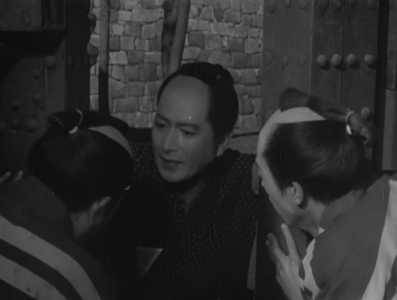
Uchida/Yoda’s narrative places two sharply contrasting worlds in opposition: the castle and the road. The movie’s first image is one of exclusion: the Tanba castle gate closes upon the hero, Yosaku, a samurai dressed as a peasant (and the father of his lover’s, Shigeno’s, child) as he seeks to gain entry. A sympathetic fellow samurai then allows him to get in through a small door within the gate, but once inside, there are more walls blocking his entry and he never gets the chance to give his newborn son the toy he is carrying.
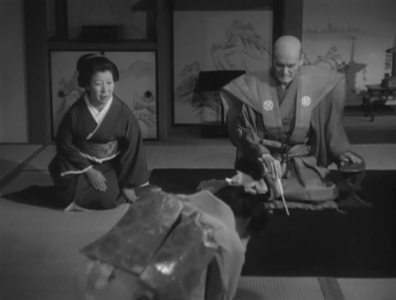
Meanwhile, inside the castle, Shigeno has just breastfed the baby boy, Yonosuke. Her parents summon her to a private room, where they confront her with the shame she has brought upon both her family and the clan through her indiscretion with Yosaku. In this scene, rigid geometric patterns are established, specifically a triangular pattern of patriarch, matriarch and daughter in which Shigeno’s father, Kotayu, appears at the apex, forming a kind of cage from which the young woman cannot escape. Despite her tears, Kotayu decides to take the newborn child away from her and assigns her to become the wet nurse to the Yurugi clan’s princess, born at about the same time as the infant boy. He even renames her “Shigenoi,” destroying her very identity.
In the final shot of the prologue, Shigenoi is carried away from the castle in a palanquin, a vehicle with the ironic double function of proclaiming her high status in relation to the common people (who have to travel on foot) and imprisoning her in a kind of box, where her sorrow will be unseen and unknown. At the same time, in the far distance of the same shot, the baby, ironically, is about to be liberated from this aristocratic prison by being removed from the castle permanently and given to a poor family to raise.1
In the next shot, which shows the samurai (now ronin) Yosaku – who now calls himself “Genjirō” – walking down a road eleven years later, the mood has immediately changed. Fukai Shirō’s music, somewhat heavy-handed at other times, sounds light and airy here, through the prominent use of woodwinds. Yosaku is shown brushing away flies with a switch, but otherwise appears content. Like the hero of Uchida’s Sweat (Ase: kigeki, 1929), he seems happier as a poor man. Uchida shows this psychological freedom cinematically, through a less rigid camera and asymmetrical compositions, and so the viewer feels subconsciously that the atmosphere has become less oppressive. As Fujita notes, roads in this film are “rich spaces where people of different social classes intersect, meet, and negotiate.”2
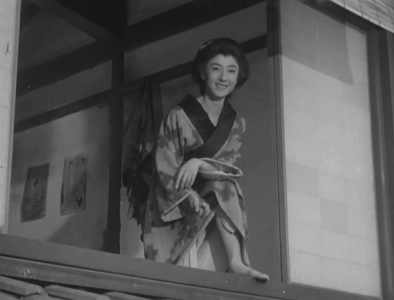
Along the way, Yosaku encounters a brash, outspoken young pack-horse driver, Sankichi, and pays the boy so he can ride his horse into the town of Seki. As the two enter the town, a young woman, the ex-prostitute Koman, observes the pair with amusement from a second-story window.
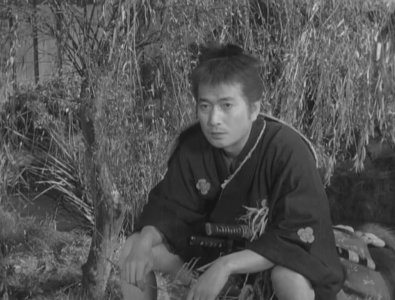
Though Yosaku outranks her even as a ronin, she is in the superior position, watching him from above, while from her point-of-view he appears ridiculous on his little horse. As Fujita puts it, “Yosaku is looked down upon, while Koman is looked up to, highlighting the contrast between the ronin’s uselessness and the prostitute’s bravery and spirit.”3 Uchida here privileges spontaneity over the false order of feudalism and its hierarchies.
The key plot event of the film is an incident involving the princess of the Yurugi clan, which serves to reunite the title character, Sankichi, with his long-lost mother. The princess sets out for Edo (modern-day Tokyo), in a long procession of retainers and serving maids, to be married to a rich lord.4 However, the little girl, who already misses Tanba and her mother, rebels and exits the palanquin in which she is being carried. She thus escapes the “box,” and Shigenoi, who is in charge of her, can’t get her to go back inside her prison.
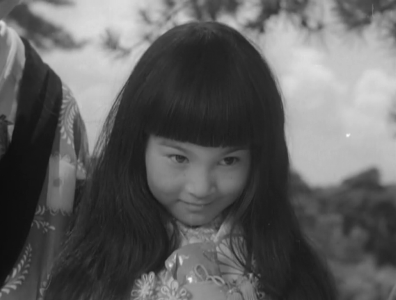
In the road ahead of the procession, the girl suddenly notices Sankichi playing a game of sugoroku (“double six”) with other horsemen, and is enchanted by both the game and the raffish little boy. The fateful decision is made to bring the boy (and his board game) along with the procession to the inn at Seki, in order to calm the princess down. The plot device of the princess meeting Sankichi on the road is a major change from the play; in the Chikamatsu work, they meet in the palace at Tanba when the boy is summoned to the castle to amuse the little girl.5
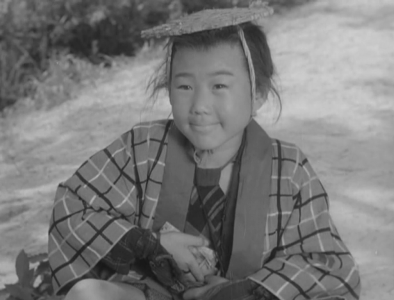
This is a crucial distinction: as Fujita points out, in the scene in the play in which Sankichi plays the game with the serving maids while the princess watches, she is seated on a high throne and he is situated below her on the floor, dramatically symbolizing their different ranks in the social order.6 In the film, because the encounter happens outdoors, this class distinction becomes blurred. When the children shyly smile at each other, there’s a sense of conspiracy between them: at that moment, they’re both rebels against the world of adults. The road thus not only allows diverse classes to “intersect, meet, and negotiate,” as Fujita says, it gives them the chance to transform each other’s lives.
How viewers feel about this film will in all likelihood be strongly influenced by their reaction to the odd behavior of the title character, the boy Sankichi. As already mentioned, Uchida had conceived this film partly as a vehicle for young Ueki Motoharu, who plays the child. Since Chikamatsu’s play featured a samurai’s-son-turned-horse-boy as a major character, it was ideal for that purpose.
Though scholar Alexander Jacoby believes The Horse Boy to be “one of Uchida’s most underrated films,” and “an engaging and moving tragicomedy,” with “a startlingly intense climax,”7 author and blogger Martin Dowsing, the biographer of Nakadai Tatsuya, was unimpressed by the work. “My personal reaction was that Sankichi’s rude behaviour did not endear him to me at all, and for this reason I was never as moved as I felt I was probably supposed to be by this film, which I would definitely consider a minor work in Uchida’s filmography.”8 But this comment appears to assume that Uchida wanted Ueki’s performance as Sankichi to be perceived as charming and the character to be seen as lovable.
On the contrary, I believe Uchida was seeking to depict not a charming but a neurotic, traumatized child. Sankichi, as depicted in this film, seems to deny he’s a child at all: he smokes a pipe and routinely disrespects adults.9 But beneath all this bravado is a hurt, scarred and scared victim, and when stressed or challenged by adults, he tends to lose control.
After seeing Yosaku and Koman chatting amiably together, Sankichi apparently becomes afraid of being abandoned by them. He goes to the Seki town square and, apparently to work off his frustration, starts beating a taiko drum as a crowd watches. But when a bystander politely asks for the drumsticks so that his son can have a chance to play the instrument too, and then becomes loud and insulting when Sankichi bluntly refuses, the boy goes utterly berserk and starts beating the man and every bystander in sight with his drumsticks, turning into a little whirling dervish of aggression. In his rage, he even throws random objects and food around, and stops only when Yosaku and Koman arrive and confront him. In shame, he runs away from them, and it’s only when Yosaku promises to serve as his surrogate father (not yet knowing he’s his actual father) that the weeping child finally calms down.
The problem is that the poor family who adopted him did not keep his lineage a secret, and thus he is fully aware that he’s a samurai’s son. This means he can’t psychologically accept his status as a lowly horse boy. As Fujita writes, “Sankichi must live with the conflict between his sense of pride as the son of a samurai and his sense of identity, and the reality that he is a foundling horse boy.”10
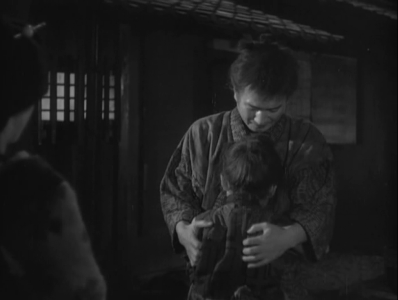
Sankichi is incapable of restraining the pain he feels from this conflicted identity. Much of Ueki’s performance therefore consists of yelling, whining or crying, so it’s little wonder that Dowsing was put off by it. Yet there are moving moments, too, such as the aforementioned one in which Sankichi dissolves in tears and embraces Yosaku, and the latter promises to look after him like a father. As in the case of A Bloody Spear at Mt. Fuji, an improvised “family” is formed around the adult male hero, in this case consisting of Yosaku, Koman and Sankichi. But this social unit is complicated by the continued existence of Sankichi’s biological mother, Shigenoi. The boy longs for his real (rather than surrogate) mother, but can’t forget or forgive the hard fact of his abandonment.
It’s occurred to me that the character of Sankichi may be meant by Uchida (and Yoda) to symbolize the emotionally damaged children orphaned by the then still-recent war. In both Japan and China during the war era, Uchida must surely have encountered many orphans, and while in the latter country he personally cared for two of them himself: the children of a Japanese photographer colleague who had perished in Manchuria. (See page 5 of my biography of Uchida on this site.) The filmmakers would probably have wished to stress, in this way, the relevance of the character Chikamatsu invented to the present historical moment.
Uchida may well have worried about this film’s commercial prospects. The story’s lack of swordplay, a staple of most of Toei’s period films, was a big problem, and this is perhaps why Uchida made the film’s only truly violent sequence so intense and memorable. Even Dowsing, who, as already noted, doesn’t care for the film as a whole, has singled out this scene for praise.11
When the stable master is informed that the katana Sankichi sold him was, in fact, stolen from the Yurugi clan, he becomes determined to return it for a 10-ryō reward – despite the fact that he must have guessed from the beginning, based on what the child said when he bought it from him, that the latter didn’t obtain the weapon honestly. To return the katana in this way would mean that the horse boy would almost certainly be executed, but the callous man cares nothing about that. But by this time, Yosaku has realized that Sankichi is his son, so he’s determined to obtain the sword by any means necessary, so as to return it personally to the clan and plead for the boy’s life.
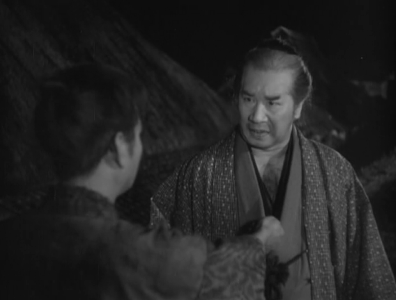
Searching desperately for the stable master, Yosaku in his haste nearly passes him on the road. The ronin then offers him a bribe of five ryō – all he has – if he would hand over the weapon, but the man sneers and gives a wonderfully derisive laugh before shoving Yosaku aside. At this point, Uchida chooses to follow the progress of the two characters as they walk along the road with a simple but brilliant tracking shot, with their subsequent struggle perfectly timed by the actors.
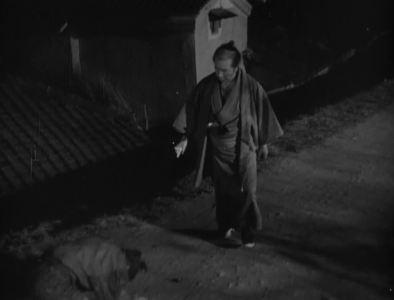
At first, Yosaku tries to stop the man by grabbing him in a headlock, but his powerful adversary literally shrugs this off. Then the ronin runs in front of him, pushes hard against his chest to stop his advance and then prostrates himself in the dirt to beg for the katana. When the stable master simply sidesteps him, Yosaku tries to grab his leg, but the other man slaps him away as if he were a mosquito.
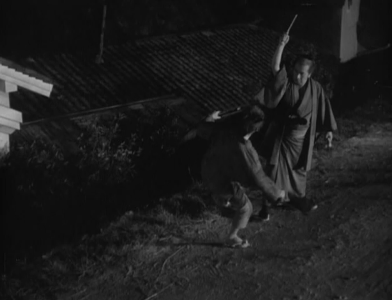
At wits’ end, the ronin attempts to pry the sword loose by force from the larger man’s hand. In a wonderfully awkward fight, the two move in circles around each other until the stable master finally pulls a dagger on his adversary. This shot is reminiscent of the one in A Bloody Spear at Mt. Fuji, in which the tattooed thief, who had been disguised all along as a Buddhist priest (and who is played by the same actor, Shindō Eitarō), is exposed by the little boy (played by Ueki Motoharu) and draws a knife on his attackers. (See our review of that film.)
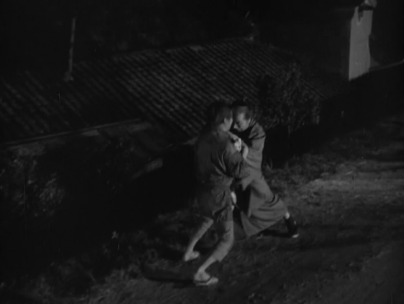
The ronin, undaunted, tries to take the man’s weapon away. The two grapple, fall down together and roll into a ditch, where the stable master is accidentally stabbed by his own dagger. The exhausted ronin only slowly realizes that he’s “murdered” the man; when he comes to his senses, he seizes the katana from the dead man’s hand and runs off with it.
The katana thus becomes yet another instance of the theme of the “wicked weapon” that destroys lives in Uchida’s films. (For a description of this theme, see my Introduction on this website.) Ironically however, the sword is never used in the course of the film, and no blood is spilled by it.
A comparison between the male protagonist of this film and that of The Master Spearman (Sake to onna to yari, 1960) is instructive. Yosaku, like Kurando in the later movie, is excluded from the feudal “system” because of behavior judged shameful in a samurai. And at first he, also like Kurando, experiences this ostracism as a kind of liberation, but both men are eventually dragged back into the system. Yet whereas the spearman experiences this change of heart because of an unexpected (one might almost say, unmotivated) revival of the warrior spirit within him, Yosaku only reclaims his samurai identity in a desperate attempt to save his son – who is also, in a sense, his best friend – by carrying out the ultimate samurai deed of honor: seppuku. If Kurando is a tragicomic antihero, Yosaku is simply tragic, and a hero in the full sense of the word.
(Continued on page 3)